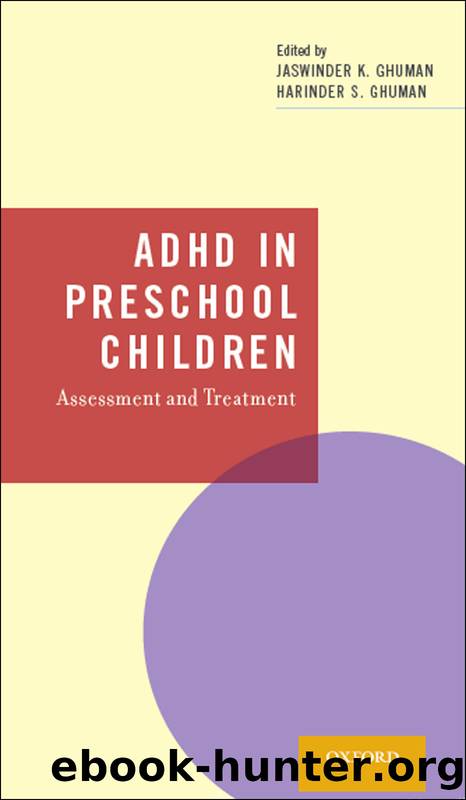ADHD in Preschool Children by Ghuman Jaswinder;Ghuman Harinder;

Author:Ghuman, Jaswinder;Ghuman, Harinder;
Language: eng
Format: epub
Publisher: Oxford University Press, Incorporated
Published: 2013-08-15T00:00:00+00:00
6 Tailoring the Incredible Yearsâ¢
Parent, Teacher, and Child Interventions for Young Children with ADHD
CAROLYN WEBSTER-STRATTON
AND JAMILA REID
Attention-deficit/hyperactivity disorder (ADHD) in young children marks a significant risk for later development of oppositional defiant disorder (ODD), conduct disorder (CD), and more serious antisocial behavior in adolescence (Beauchaine, Hinshaw, & Pang, 2010; Campbell, Shaw, & Gilliom, 2000). Children with ADHD are impulsive, inattentive, distractible, and hyperactive. They have difficulty attending to, hearing, or remembering parental or teacher requests and anticipating consequences and therefore donât seem to be cooperative or to learn from negative consequences. Because of their distractibility, they have difficulty completing tasks such as schoolwork, homework, chores, or other activities that require sustained concentration. Many children with ADHD have difficulties with peers (Coie, 1990; Coie, Dodge, & Kupersmidt, 1990; Coie & Koepple, 1990; Menting, Van Lier, & Koot, 2011). Because of their impulsivity, it is hard for them to wait for a turn when playing, use their words to ask for what they want, or concentrate long enough to complete a game or make a better decision. They are more likely to grab things away from other children or disrupt an ongoing activity because of their impulsivity and lack of patience. In fact, research has shown these children are delayed in their play and social skills (Barkley, 1996; Webster-Stratton & Lindsay, 1999). For example, a 5-year-old with ADHD plays more like a 3-year-old and will have difficulty with sharing, waiting, taking turns, and focusing on a play activity for more than a few minutes and is more likely to be engaged in solitary play. Because these children are annoying to play with, they have few same-age friends, and other children frequently reject them. They are usually the children who are not invited to birthday parties or play dates, a problem that compounds their social difficulties by reducing their social learning opportunities and lowering their self-esteem.
Between 20% and 60% of children with ADHD have a comorbid diagnosis such as ODD, language delays, or learning disabilities (Beauchaine, et al., 2010; Beauchaine & Waters, in press; Ghuman, Arnold, & Anthony, 2008; Ghuman, et al., 2007). ADHD symptoms, externalizing behaviors, and academic and developmental problems are intertwined with social and emotional problems. For example, impulsive and/or oppositional behaviors make it difficult for children to function in a school setting with peers and teachers. Poor attention, hyperactivity, and language or reading difficulties limit childrenâs ability to engage in academic learning and also result in less encouragement and instruction from teachers as well as parents. Thus children with ADHD are likely receiving negative feedback from their peers, parents, and teachers, creating a cycle whereby one problem exacerbates the other (Barkley, 1996; Dishion & Piehler, 2007).
Download
This site does not store any files on its server. We only index and link to content provided by other sites. Please contact the content providers to delete copyright contents if any and email us, we'll remove relevant links or contents immediately.
When Breath Becomes Air by Paul Kalanithi(7274)
Why We Sleep: Unlocking the Power of Sleep and Dreams by Matthew Walker(5658)
Paper Towns by Green John(4178)
The Immortal Life of Henrietta Lacks by Rebecca Skloot(3833)
The Sports Rules Book by Human Kinetics(3597)
Dynamic Alignment Through Imagery by Eric Franklin(3499)
ACSM's Complete Guide to Fitness & Health by ACSM(3472)
Kaplan MCAT Organic Chemistry Review: Created for MCAT 2015 (Kaplan Test Prep) by Kaplan(3429)
Introduction to Kinesiology by Shirl J. Hoffman(3306)
Livewired by David Eagleman(3134)
The River of Consciousness by Oliver Sacks(2998)
Alchemy and Alchemists by C. J. S. Thompson(2917)
The Death of the Heart by Elizabeth Bowen(2909)
Descartes' Error by Antonio Damasio(2745)
Bad Pharma by Ben Goldacre(2735)
The Gene: An Intimate History by Siddhartha Mukherjee(2500)
Kaplan MCAT Behavioral Sciences Review: Created for MCAT 2015 (Kaplan Test Prep) by Kaplan(2494)
The Fate of Rome: Climate, Disease, and the End of an Empire (The Princeton History of the Ancient World) by Kyle Harper(2443)
The Emperor of All Maladies: A Biography of Cancer by Siddhartha Mukherjee(2438)
